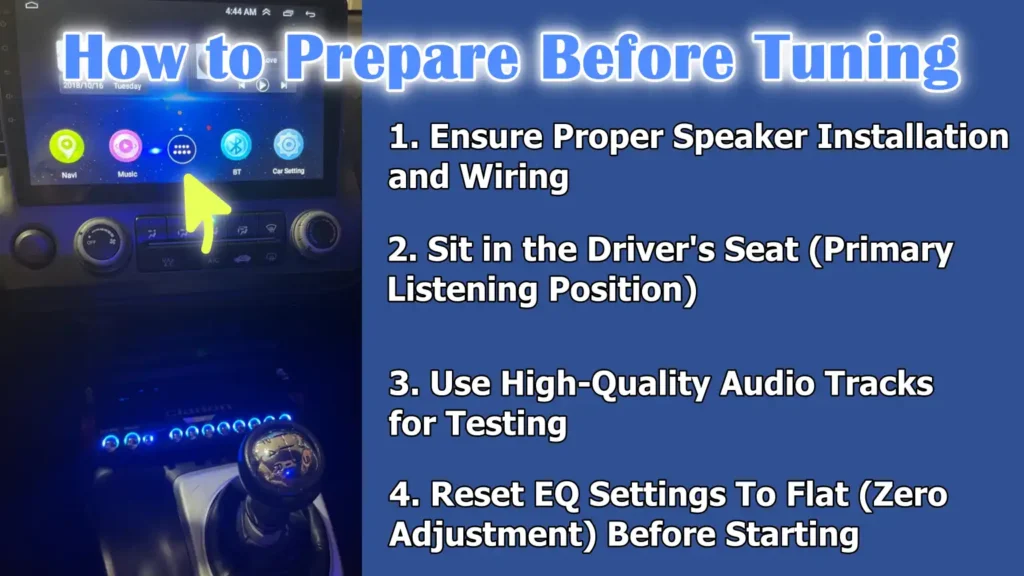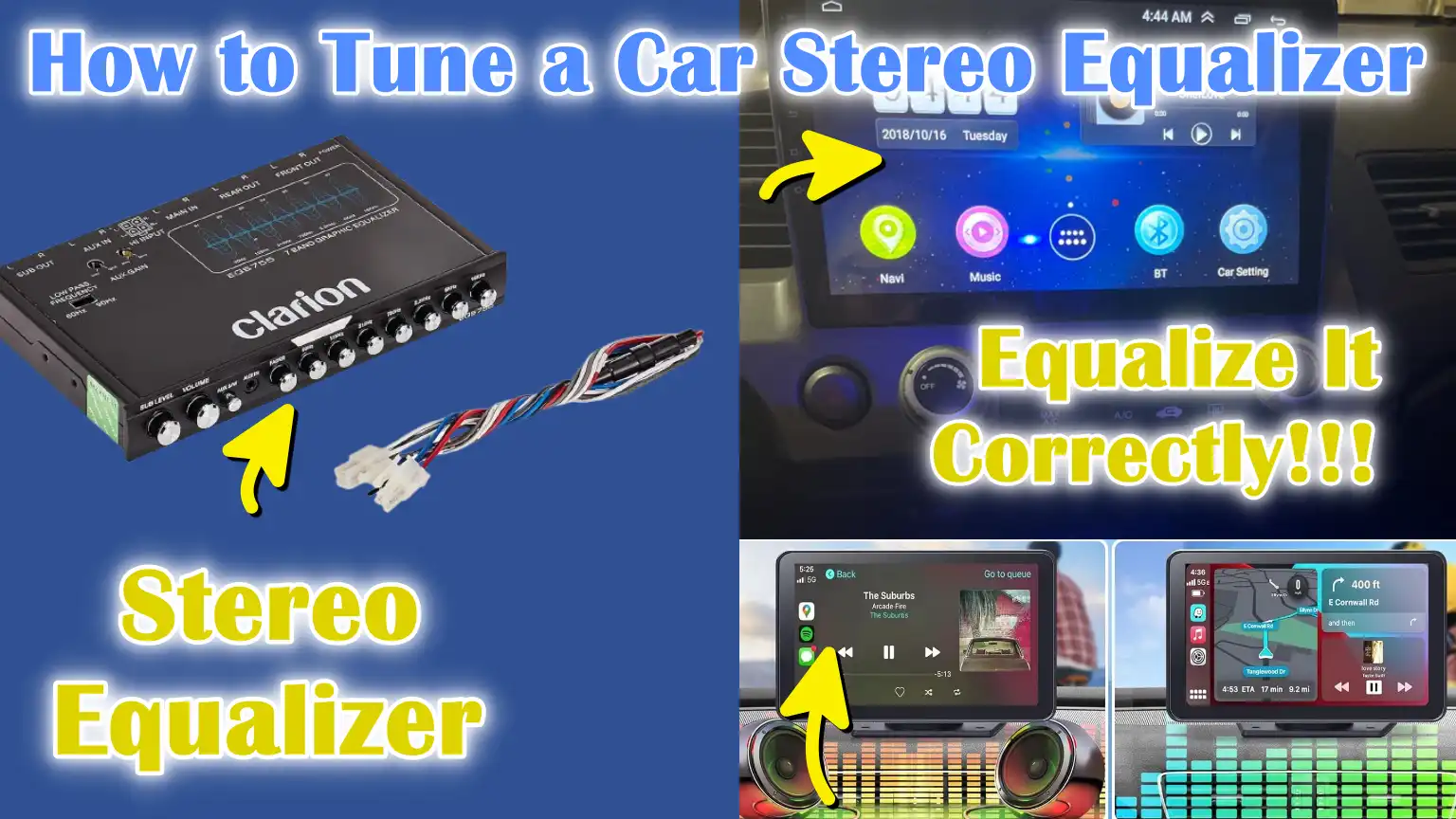Written By: Don Dodi
Fact Checked By: Kristen Brown
Reviewed By: Diego Rosenberg
If your stereo is poorly tuned then even the best of the best songs sound flat, but don’t worry about it as you just need a well-tuned EQ that unlocks the full potential.
And it is true that a car Stereo Equalizer is one of the most powerful and yet it is often overlooked tools for improving in-car audio quality, yes most factory stereos comes with preset sound modes such as “Rock”, “Jazz” or Pop” but these rarely deliver the clarity and balance that listeners truly wants.
So, basically an Equalizer works by dividing sound into different frequency ranges such as: bass, midrange and treble and it ideally allows you to boost or reduce specific tones until the audio matches your preferences completely.
As an example: the bass frequencies of 20 to 200 Hz actually gives depth and thump to the music, then the midrange which is 200 Hz-to 4000 Hz actually brigs out vocals and instruments, while treble frequencies from 4000 to 20,000 Hz actually adds sharpness and detail to the music.
As well as, studies in acoustics shows that poorly tuned car audio can even lead to the ear fatigue and muffled sound and then even it doesn’t matter as if you have a high-quality speakers, on the other hand perfectly tuned EQ can have the capability to transform the listening experience into something closer to a live performance.
So, this guide is simply on How to Tune a Car Stereo Equalizer, so that you can have crisp sound by these effective ways covered in this guide.
Understand the Basics of a Car Stereo Equalizer
A car stereo equalizer is a device that lets you adjust the sound balance in your vehicle.
It works by dividing music into different frequency ranges and allowing you to increase or decrease the volume of each range.
By doing this, the equalizer helps you make the sound more clear, balanced and tailored to your personal preference.
Without an equalizer, all frequencies play at the same level, which can cause some songs to sound muffled, overly bassy, or harsh.
1. What is an equalizer and how does it work?
An equalizer, often called EQ, is a tool or software built into most modern car stereos.
It divides the audio signal into different frequency bands and gives you control over each one.
For example, if the bass is too loud and overpowering the music, you can reduce it.
If vocals or instruments sound weak, you can boost the mid frequencies.
This process improves overall clarity and ensures that every element of the song can be heard correctly.
Understanding how EQ works is essential to making music sound natural and enjoyable while driving.
2. General Frequency Ranges (Bass, Midrange, Treble)
Sound is generally divided into three main frequency ranges: bass, midrange and treble.
Bass ranges from approximately 20 Hz to 200 Hz and gives music depth and emphasis, specially in drums and low notes.
Midrange ranges from approximately 200 Hz to 4 kHz and is where most vocals and instruments are located, making it most important for clarity.
Treble ranges from 4 kHz to 20 kHz and adds sharpness, brightness and nuance to the sound.
Each frequency range affects how you hear music and small adjustments can make a big difference in the listening experience.
3. Different Types of Equalizers (Graphic EQ, Parametric EQ, Presets)
There are several types of equalizers, each of which offers different levels of control.
A graphic equalizer displays multiple sliders for different frequency bands, allowing you to visually adjust each one.
A parametric equalizer offers more precise control over the exact frequency, bandwidth and gain, which is useful for fine-tuning.
Many car stereos also have presets, such as rock, jazz, or classical, that automatically adjust frequencies for specific types of music.
While presets are convenient, manually adjusting the EQ often yields the best results because it’s customized to your car, speakers and personal preferences.
How to Prepare Before Tuning

Before adjusting your car stereo equalizer, proper preparation is essential.
Following these steps ensures that your adjustments are accurate, effective and provide you with the best possible sound in your car.
Neglecting preparation can result in incorrect settings, which can worsen music rather than improve it.
1. Ensure Proper Speaker Installation and Wiring
The first step is to ensure that all your car’s speakers are properly installed and wired.
Incorrectly installed speakers or loose wires can cause distortion, buzzing, or weak sound, which EQ cannot correct.
Check that each speaker is securely installed, the connections are clean and there are no damaged wires.
A properly installed system is the foundation for accurate EQ adjustment.
2. Sit in the Driver’s Seat (Primary Listening Position)
When tuning your EQ, always sit in the driver’s seat or your primary listening position.
This is because the sound will be different in other locations in the car due to reflections and speaker position.
Adjusting while sitting in the main position allows you to hear how the music will sound most of the time and ensures a balanced sound level for vocals and instruments.
3. Use High-Quality Audio Tracks for Testing
Choose high-quality audio tracks for EQ testing.
Preferably, use familiar songs that you know well.
This helps you recognize changes in sound and hear improvements clearly.
Low-quality music files, such as highly compressed MP3s, can hide details and make tuning less accurate.
Using a variety of songs with different instruments and vocals improves overall adjustment.
4. Reset EQ Settings To Flat (Zero Adjustment) Before Starting
Always reset your equalizer to flat settings before starting.
Flat means that all frequencies are at zero, so no range is boosted or downplayed.
Starting with flat provides a neutral baseline, making it easier to identify which frequencies need adjustment.
If you start with an existing preset, it may already have boosts or cuts applied that can confuse you and prevent you from achieving a balanced sound.
How to Tune a Car Stereo Equalizer – Full Tuning Process
Tuning a car stereo equalizer requires patience, attention and a systematic approach.
By carefully adjusting each frequency range and making gradual changes, you can achieve a clear, balanced and harmonious sound.
The following steps will guide you through this process and ensure that every element of your music is accurately presented.
1. Adjust the Bass Frequencies
Bass frequencies are the lowest sounds in your music, ranging from 20 Hz to 200 Hz.
Sub-bass (20-80 Hz) adds deep rumble and impact, while mid-bass (80-200 Hz) gives drums, bass guitar and other low-pitched instruments a robust sound.
When adjusting the bass, it’s important to prevent distortion or speaker rattle.
Too much boost can damage speakers or muffle the sound, while too little bass can make music dull and lifeless.
Start with small adjustments and listen carefully to achieve a full, controlled low-end sound.
2. Adjust the Mid Frequencies
Mid frequencies range from 200 Hz to 4 kHz and are most important for vocals, guitars, keyboards and other instruments.
Proper adjustment ensures clear vocals and distinct instruments.
If mid frequencies are too high, the sound can become harsh or piercing.
If they are too low, the music may sound hollow, boxy, or disjointed.
Make gradual adjustments while listening to familiar songs, focusing on clarity and balance between vocals and instruments.
3. Adjust the Treble Frequencies
Treble frequencies from 4 kHz to 20 kHz provide brightness, detail and airiness to music.
Proper treble adjustment improves cymbal, hi-hat and vocal harmonics without creating harshness.
Excessive treble can tire the ears, making listening uncomfortable for long periods, while too little treble can make music sound dull or lifeless.
Carefully tune the treble for clarity and smoothness.
4. Left/Right and Front/Rear Balance
After adjusting the individual frequencies, use the Balance and Fader controls to create a uniform sound level.
Balance adjusts the sound between the left and right speakers, while the Fader adjusts it between the front and rear speakers.
Proper balance ensures that the sound sounds focused and impactful from the driver’s seat, so that all instruments and vocals in the car are heard equally.
5. Make Gradual Adjustments
Improving EQ is a gradual process.
Make small adjustments, listen carefully after each change and repeat as needed.
This prevents overcorrection and helps you achieve the most natural and enjoyable sound.
Testing with different types of music ensures that your settings work for different songs, not just one.
Gradual adjustments and careful listening create the ideal personal audio experience.
How to Test and Tune it Perfectly
After adjusting the equalizer, the next step is to test and fine-tune your settings to ensure the sound remains clear, balanced and enjoyable in different situations.
This process is important because the sound of music can vary depending on volume level, song type and speaker performance.
Taking the time to carefully test and refine your EQ will help you achieve the best listening experience.
1. Play music from different genres to test versatility
Different genres of music emphasize different frequencies.
For example, classical music emphasizes midrange and treble, hip-hop focuses on bass and rock emphasizes a mix of midrange and treble.
Playing different genres allows you to hear how your adjustments affect each type of music.
This ensures that your EQ settings are versatile and not just tuned to a single genre, providing a balanced sound for all listening situations.
2. Adjust for both low and high volume levels
Sound can behave differently at low and high volumes.
At low volumes, bass may be less audible, while higher volumes may reveal distortion or speaker weaknesses.
Testing your EQ at multiple volume levels helps identify which frequencies may need additional adjustment.
This ensures that music remains clear and balanced, whether you’re listening quietly during a commute or turning up the volume on a long drive.
3. Check for distortion, rattles, or imbalances
During testing, pay attention to any distortion, speaker rattles, or uneven sound in the car.
Distortion typically occurs when frequencies are overly amplified, while rattles indicate loose speaker parts or panels.
Imbalances between the left and right or front and rear speakers can cause music to sound off-center.
Correcting these issues during testing ensures that your EQ adjustments produce smooth, natural and high-quality audio.
Common Mistakes to Avoid
Despite good intentions, many people make mistakes when tuning their car stereo equalizer that diminish sound quality rather than improve it.
Being aware of these common mistakes can help you avoid them and achieve a more accurate, balanced and enjoyable listening experience.
1. Boosting All Frequencies Instead of Balancing
A common mistake is increasing the volume of all frequencies simultaneously, thinking this will make music sound better.
Boosting every frequency can cause distortion, blur and listener fatigue.
The key to good sound is balance—carefully adjusting each frequency so that the bass, midrange and treble work harmoniously together rather than competing for attention.
2. Ignoring Speaker Quality and Placement
Speakers are the foundation of your car audio system and no amount of EQ tuning can fully compensate for poor quality or improper placement.
Low-quality speakers may not reproduce certain frequencies accurately, while incorrect placement can create uneven sound distribution in the car.
Before making any EQ adjustments, it’s essential to ensure that the speakers are high-quality, properly installed and in good condition.
3. Overemphasizing Bass or Treble
Many people overemphasize bass or treble, believing that too much low or high frequency makes music more impressive.
Excessive bass can overwhelm vocals and midrange instruments, while too much treble can cause harshness and ear fatigue.
A well-tuned EQ balances all frequencies, making music sound natural, clear and detailed without overemphasizing any particular range.
4. Relying solely on presets without manual fine-tuning
Factory EQ presets like Rock, Jazz, or Pop are convenient, but they’re designed for general use, not for your specific car and speakers.
Relying solely on presets can result in uneven sound and limit the system’s full potential.
Manual fine-tuning lets you precisely adjust frequencies to suit your car’s acoustics, speaker quality and personal listening preferences, delivering a superior audio experience.
Read More:
Advanced Tips
Once you’re familiar with basic EQ adjustments, there are several advanced techniques that can further enhance your car audio experience.
These tips help achieve better accuracy, clarity and balance, specially for those seeking professional-level sound.
Not only this, If your equalizer has limited processing capabilities then you should utilise spectral smoothed FIR filters in car audio systems, as it aims to build short filters that can be processed on DSP processors with limited computing power. As well as, independent phase and magnitude smoothing techniques further improves the filter performance and in that way it ensures high-quality sound reproduction.[¹]
1. Using an SPL Meter or Tuning App for Accuracy
An SPL (sound pressure level) meter or tuning app can measure the precise volume levels of different frequencies in your car.
This allows you to make precise adjustments instead of relying solely on your ears.
Using these devices ensures an accurate balance of bass, midrange and treble and helps detect peaks or dips in frequencies that may be missed during normal listening.
Accurate measurements improve overall sound quality and make your tuning more consistent.
2. Adjusting Crossover Settings, If Available
Many car audio systems have crossover settings that control which frequencies go to which speakers.
Adjusting these settings can prevent distortion and improve clarity by sending the correct frequency range to the appropriate speakers.
For example, low frequencies are best handled by subwoofers, while mid- and high frequencies are ideal for door or dashboard speakers.
Proper use of crossovers ensures that each speaker works efficiently and produces the best possible sound.
3. Considering Professional Tuning for Audiophiles
For those seeking the highest level of audio performance, it may be beneficial to consider professional tuning.
Audio experts use advanced equipment and experience to optimize every aspect of a car stereo system, including speaker placement, EQ settings, phase alignment and acoustic treatment.
Professional tuning can highlight subtle details in music, improve sound staging and provide a more immersive listening experience that is difficult to achieve with manual adjustments alone.
Conclusion – How to Tune a Car Stereo Equalizer
When you tune your EQ that means you are creating a perfectly balanced sound that actually makes every song feel alive.
By understanding how EQ works, adjusting bass, midrange and treble frequencies and carefully experimenting with different musical styles, you can create a sound that’s clear, balanced and tailored to your personal preferences.
Proper speaker placement, careful listening and the use of high-quality music tracks make the tuning process more precise and enjoyable.
Avoiding common mistakes like overemphasizing the bass or relying solely on presets ensures your adjustments produce a natural and detailed sound.
For enthusiasts seeking the highest quality, advanced tools like SPL meters, crossover adjustments and professional tuning can further enhance the listening experience.
Ultimately, tuning your EQ can unlock the full potential of your car audio system, making every drive more immersive and enjoyable, while also giving you control over the sound of music in your vehicle.
Now, you can comment down below your thoughts about this guide and if you still have confusion about anything please let us know that as well in the comment box.
Frequently Asked Questions
Q1. What is a car stereo equalizer and why is it important?
Answer: A car stereo equalizer is a tool that allows you to adjust different parts of the sound in your car, such as bass, midrange and treble. It’s essential because it helps make music sound clear, balanced and to your liking. Without EQ adjustments, music can sound faint, slow, or harsh, even if you have good speakers.
Q2. How do I know which frequencies to adjust first?
Answer: Start with bass frequencies, which are the lowest sounds in music and provide depth and impact. Then move to midrange frequencies to balance vocals and instruments and finally adjust treble frequencies to add clarity and detail. Always make small changes and listen carefully after each adjustment to avoid distortion or harshness.
Q3. Should I use presets or adjust my EQ manually?
Answer: Presets like Rock, Jazz, or Pop are convenient and provide a starting point, but they may not be suitable for your car and speakers. Manual adjustments yield better results because you can better adjust the sound based on your specific vehicle, speaker quality and listening preferences.
Q4. Do I need special equipment to tune my car stereo?
Answer: No special equipment is required for basic tuning, but using tools like an SPL meter or tuning app can help you make more precise adjustments. These tools measure the precise levels of different frequencies, which is specially useful for audiophiles or those who want a very precise sound.
Q5. Can tuning the EQ damage my speakers?
Answer: Careful tuning of the EQ will not damage your speakers. The risk arises when frequencies, specially bass, are boosted too much at high volumes. Overboosting can cause distortion or rattling, so it’s important to make adjustments gradually and listen carefully for any signs of strain.
References:
[1] Digital Equalization of Automotive Sound Systems Employing Spectral Smoothed FIR Filters
https://www.researchgate.net/publication/233833361_Digital_Equalization_of_Automotive_Sound_Systems_Employing_Spectral_Smoothed_FIR_Filters

Guys, I’m a car audio enthusiast and customization expert and I love clear sound and clean installation. Plus, I have spent years helping people build their dream audio setups. And whenever I’m working on cars, I probably listen to music and thinks about the next big upgrade.

